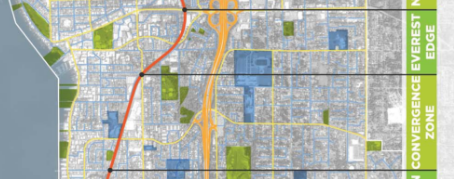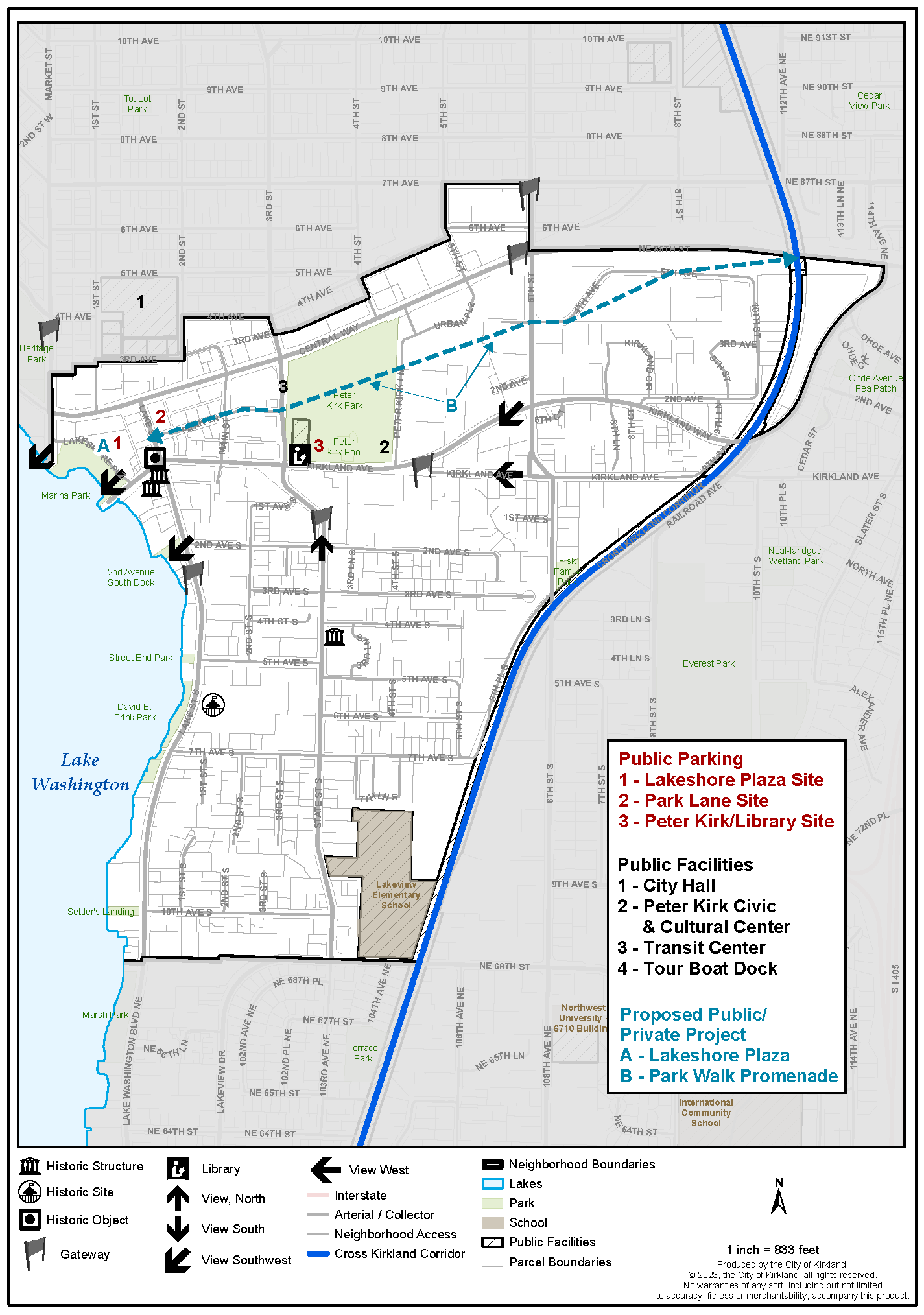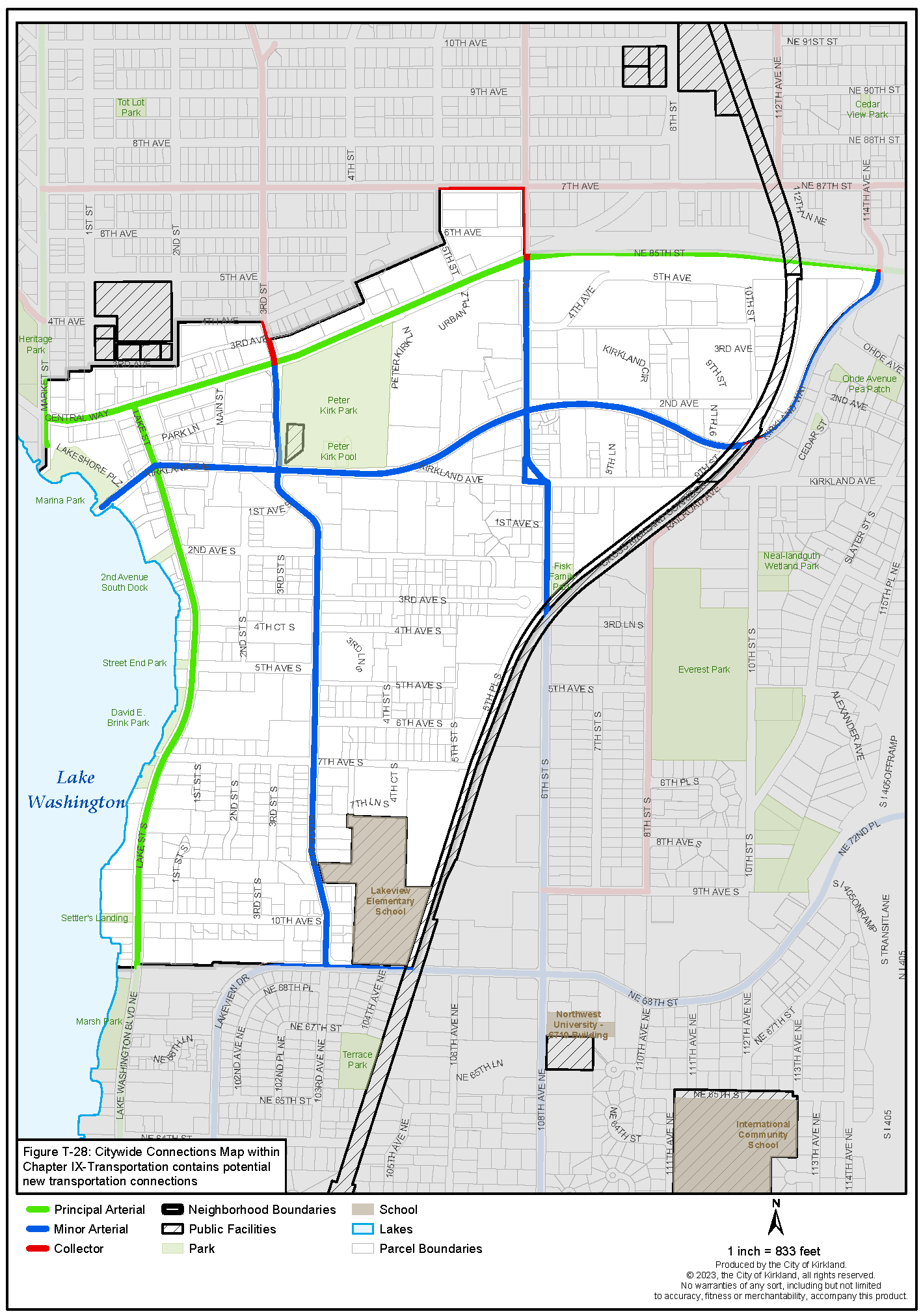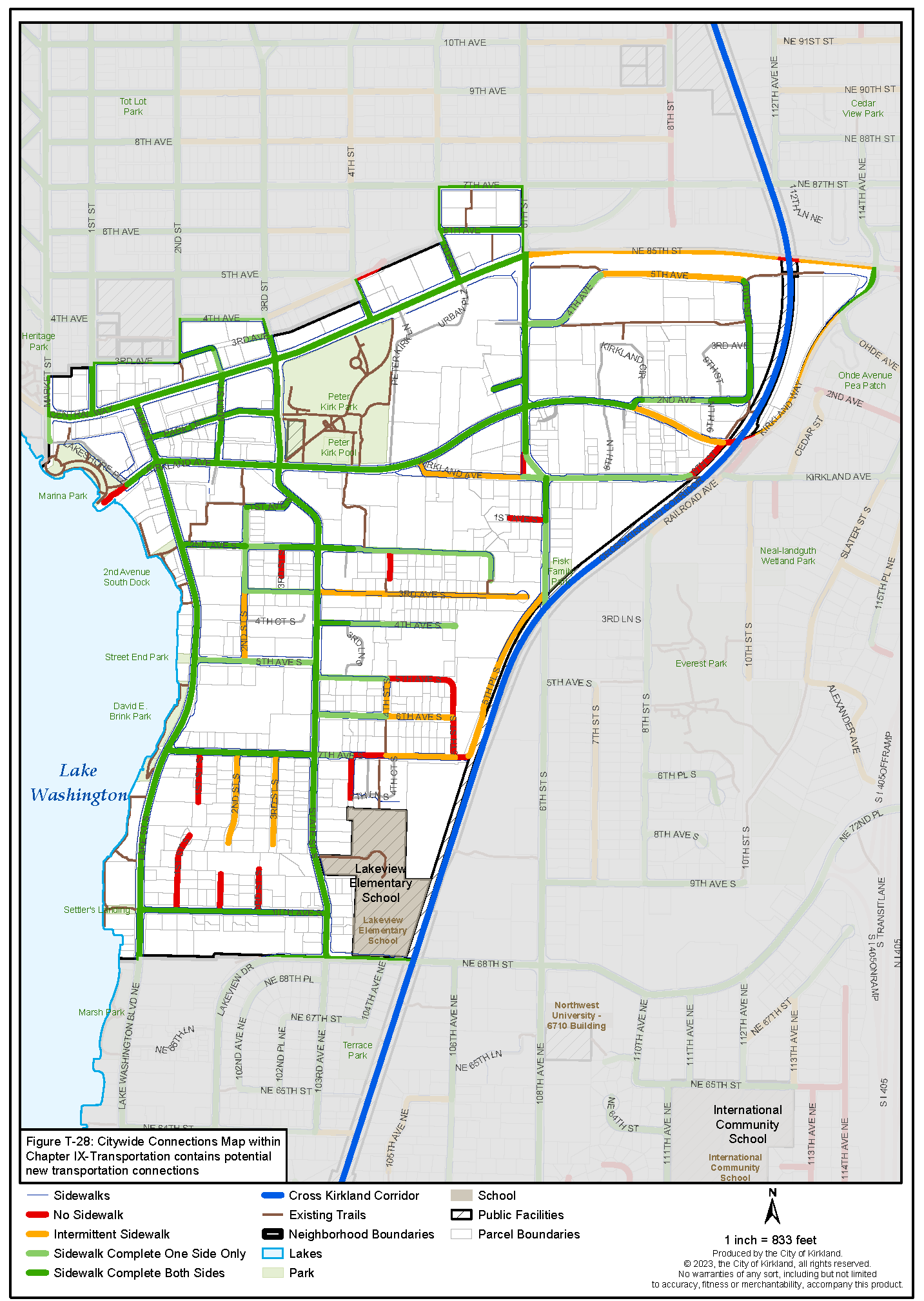6. TRANSPORTATION
The circulation routes in the Moss Bay neighborhood are well established (see Figure MB-6). There is a relatively large flow of traffic through the area, in addition to traffic generated by activities within the Downtown. The major north/south traffic corridors include Lake Street, State Street, 3rd Street, and 6th Street South. The major east/west corridors include Central Way, Kirkland Avenue/Kirkland Way, and NE 68th Street.
The Moss Bay neighborhood has some of the City’s best transit, walking, and bicycle routes that can move people efficiently and with less congestion than traditional modes of travel. However, it is acknowledged that many vehicles need to move through the neighborhood to connect to Downtown from many other places.
“Mode split” is the term used to describe how trips are allocated amongst various types of transportation, or modes. The Transportation Element in Kirkland’s Comprehensive Plan identifies the baseline estimate of the mode splits and the goals for future mode splits in the Downtown Central Business District (CBD).
Current mode split in the CBD is low because it does not currently include any major Commute Trip Reduction (CTR) employers. In contrast, large CTR employers just outside the CBD and within the Greater Downtown Urban Center are currently achieving mode splits resulting in drive-alone rates between 62% and 78%.
|
Downtown Kirkland (CBD) Existing Mode Split (2018) Peak Hour, Work Trip Types |
|
|---|---|
|
Mode |
Fraction of Trips |
|
Drive Alone |
88% |
|
Transit |
1% |
|
Rideshare |
5% |
|
Walk and Bike |
6% |
The future goals for the Totem Lake and Greater Downtown Urban Centers are shown below:
|
Totem Lake and Greater Downtown Mode Split Goals, Peak Hour, All Trip Types |
|
|---|---|
|
Mode |
Fraction of Trips |
|
Drive Alone |
45% |
|
HOV 2+, Vanpool, Transit |
46% |
|
Walk and Bike |
9% |
It is important that people have acceptable options besides private vehicles, so that public transit, walking, and cycling become more desirable. Equally important are connections for public transit and innovative non-motorized mobility options to get to the CKC and regional transportation systems so that the entire transportation system is efficient.
A. Public Transit
Third Street has been designed for the pedestrian and public transit user, with the METRO transit center located on this street. The use of public transportation as an alternative for people who work or shop in the Downtown should be encouraged. Increased use of transit would help to reduce traffic congestion and parking problems in the Downtown area. The NE 85th Street BRT/Stride station will be a major transportation hub with regional connections when it is complete. The Stride station will be a major asset to the Moss Bay neighborhood with supporting pedestrian, bike, and land use infrastructure in place to fully leverage this regional transit investment.
Policy MB-21:
Ensure that transit service and all modes of transportation are aligned and efficient through the Greater Downtown Urban Center, including the NE 85th Street Station Area.
Implementation of the Transportation Master Plan will play an important role in making seamless connections between the urban center and the NE 85th Street Station Area including the BRT/Stride station and the Cross Kirkland Corridor.
Policy MB-22:
Utilize the most innovative and effective methods to move people through the neighborhood and to connect to the surrounding community and region.
As new technology emerges, so must the ways to enhance connections throughout the neighborhood, which could include pilot projects and initiatives connecting existing and future transportation infrastructure.
Policy MB-23:
Partner with transit agencies and larger employers to foster enhanced and frequent transit service to and from Downtown and other regional connections.
The connections between modes of transit and major employers is integral to the entire system and partnerships can ensure that moving people remains a priority.
Policy MB-24:
Explore new and innovative means of micro-mobility to allow people to easily make last-mile connections from transit.
Last-mile connections are often the missing link to greater public use of the existing transit system. As part of the Transportation Master Plan, implementing new forms of micro-mobility can help bridge this gap.
Policy MB-25:
Explore establishing ferry service to and from Downtown Kirkland as part of the Transportation Master Plan update process.
Ferry service to and from Downtown Kirkland has long been part of the City’s history. Consideration should be given for a pedestrian and bicycle ferry service as another tool to enhance current and future growth in the neighborhood.
B. Pedestrian and Bicycle Circulation
Pedestrian routes should have higher priority than vehicular routes in Downtown circulation. Pedestrian amenities and routes should continue to be improved and should be given higher priority than vehicular routes for circulation within the Downtown. Modifications to the street network and traffic patterns should not be allowed to disrupt Downtown pedestrian activity and circulation.
The establishment and improvement of pedestrian pathways between activity centers should be a high-priority policy objective. Major pedestrian routes within the Downtown area are identified in Figure MB-5. Major pathways include the extensive east-west “spine” or “Park Walk Promenade,” which links the lake with points east of 6th Street and the shoreline public access trail.
Figure MB-6 also identifies other important pedestrian routes which provide north-south pedestrian access. Improvements to these pathways should be promoted, particularly at the intersection of 6th Street and Central Way.
Policy MB-26:
Complete and enhance the existing sidewalk network and consider sidewalk widening pilot projects to ensure public safety and further promote a pedestrian oriented neighborhood.
There are numerous opportunities to add and improve sidewalks to promote connectivity within the neighborhood, to surrounding neighborhoods, and regionally via the CKC and Stride station. See Figure MB-7.
To be a truly successful walking environment, the core area of the Downtown must be safe, convenient, and pleasant for pedestrians of all ages. Pedestrian safety should continue to be a high priority in the placement and design of intersections, crosswalks, and sidewalks throughout the neighborhood.
Policy MB-27:
Explore the construction of systems of overhead coverings to improve the quality of major pedestrian walkways year-round.
The continued creation of a system of overhead coverings such as awnings, arcades, and marquees provide protection to the pedestrian during inclement weather, allowing for pedestrian activity year-round. These features also add visual interest and vitality to the pedestrian environment.
Policy MB-28:
Implement ongoing pilot projects to improve pedestrian and bicycle conditions along Lake Washington Boulevard, including conversion and reallocation of vehicle lanes and parking areas.
The sidewalks along Lake Washington Boulevard connect many parks and offer scenic views of Lake Washington that could be further enjoyed if there were more space available for pedestrians.
More community members would like to make more trips by bicycle; one reason they do not is because the current network of on-street bicycle lanes does not meet their needs for safety and convenience. In order to unlock the potential of bicycling, the existing network of on-street bicycle lanes should be improved with facilities that people of all ages and abilities find safe and welcoming.
Policy MB-29:
Create new and enhance existing pedestrian, bicycle, and transit connections between the lake-front commercial district, Kirkland Urban, the NE 85th Street Station Area Plan, and the Cross Kirkland Corridor.
The Park Walk Promenade identified in Figure MB-5 should consist of a series of minor structures placed at prominent locations along the walkway in order to clearly identify the pathway throughout its length, as well as to provide some protection during wet weather. The walk serves the Peter Kirk Park civic and cultural center, as well as commercial areas to the east and west. The current promenade concept under consideration by the City now should be encouraged as it offers a unique way to move people from the Lakeshore marina area though the Downtown area all the way to the CKC.
Policy MB-30:
Ensure seamless bike and pedestrian connectivity with options for people of all ages and abilities and provide and/or improve non-motorized mobility connections to the Cross Kirkland Corridor.
Convenience to the pedestrian will be enhanced by improving the directness and ease of pedestrian routes. “Shortcuts” between streets, or even between buildings, can link pedestrian routes over large distances where vehicles cannot circulate. Bicycle routes including building proposed greenways can also be helpful in creating safe routes for cyclists and care should be taken so cyclists young and old can use these routes.
Access points to the CKC along the Convergence Zone and Everest Edge in the Moss Bay neighborhood can provide safe, logical, well-marked connections to the street network for pedestrians and cyclists. The CKC also provides an additional route to the regional light rail system in Bellevue. In addition, the proposed greenways increase points of access, further enhancing the user experience.
Policy MB-31:
Explore the possibility of an innovative off-surface transportation system such as a gondola to connect the BRT/Stride Station, Kirkland Urban, and potentially other nearby employment centers.
The construction of the NE 85th Street BRT/Stride station provides an excellent opportunity to consider how to efficiently move people using new ideas and technologies that don’t increase congestion and traffic, mitigate the barrier formed by I-405, and improve accessibility.
Figure MB-5: Moss Bay Urban Design Features

Policy MB-32:
Expand and iterate pilot programs to enhance pedestrian-only access along Park Lane.
Park Lane in Downtown Kirkland was originally designed to be a pedestrian-oriented street with slow-moving wheeled traffic and has previously been closed to motor vehicles during select special events. In coordination with the Downtown community, in 2020 the City started “Evenings on Park Lane” where the street was opened to people walking and wheeling beginning at 6 p.m. during the warmer months. This allowed more outdoor space for restaurant seating and retail uses while also providing safe places for people to socialize. Data and observations from the Evenings program, along with other pilot projects that seek to repurpose street space for people, should be evaluated to consider other similar temporary and permanent programs in the future.
Figure MB-6: Moss Bay Street Classifications
Figure MB-7: Moss Bay Pedestrian System
Figure MB-8: Moss Bay Bicycle System








